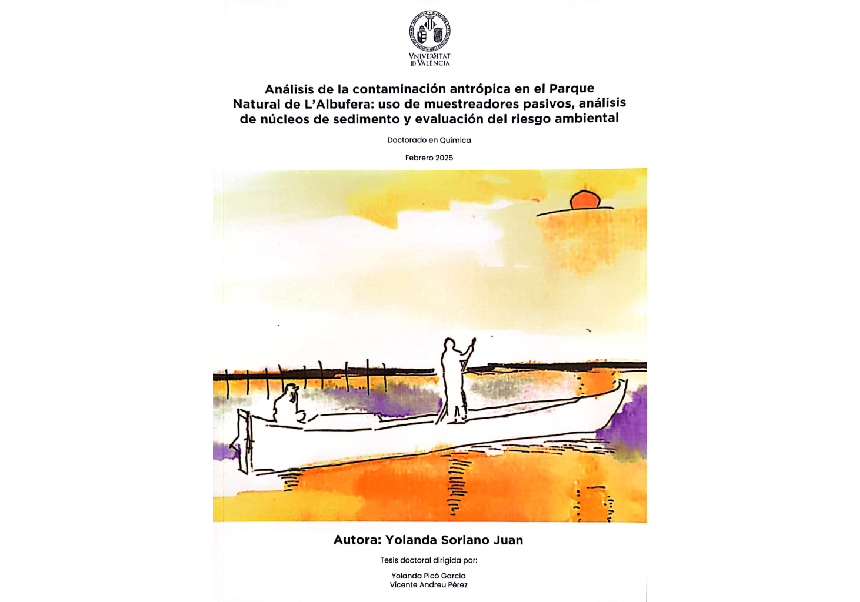
Thesis No.: 18417
Deposit date: 07/04/2025
Title: Evaluation of anthropogenic pollution in L'Albufera Natural Park: use of passive samplers, analysis of sediment cores and determination of environmental risk.
Author: Yolanda Soriano Juan
Department: C02 Faculty of Chemistry
Program: 3154 Chemistry
Area: Basics
Center: 46014731 Facultat de Químiques
Reading center: 46014583 Facultat de Farmacia
Reading place: Salón de Grados Facultad de Farmacia. Av. Vicent Andrés Estellés S/N 46100, Burjassot
Reading time: 11:00:00
Date of reading: 21/05/2025 11:00:00
Summary:
The Albufera de Valencia Natural Park (Spain) is a relevant case study among Mediterranean coastal wetlands because it has experienced significant ecological deterioration since the 1970s, caused by natural and, above all, anthropogenic factors. Domestic, industrial and agricultural activities, together with population growth, have introduced a wide variety of pollutants. The persistence of these chemical compounds, even at low concentrations, can lead to their accumulation in various environmental compartments and represent a significant risk to these ecosystems. Thus, the general objective of the doctoral thesis is to establish the presence, fate and ecological risk implied by the presence of organic pollutants in the Natural Park of L'Albufera de Valencia.
First, an exhaustive bibliographic review was carried out to deepen in the most recent analytical techniques to determine the contamination profile in aquatic ecosystems, with special emphasis on wetlands. This review highlights the interest of obtaining representative samples over time, and the need to establish a complete contamination profile, and not only determine a few pollutants selected a priori by the analyst. The experimental development of the thesis involved the use of passive samplers to evaluate the medium-term presence of anthropogenic pollutants, such as pesticides, pharmaceuticals and personal care products (PPCPs), perfluoroalkylated and polyfluoroalkylated substances (PFASs) and organophosphorus flame retardants (OPFRs) in water. Passive porous polyethylene samplers were used for medium-term monitoring of contaminants in the Natural Park to characterize exposure and ecological risks. Also, in order to assess the historical contamination of the Park in the longer term, sediment cores (cores) were collected from a depth of 1 m in the northern and southern areas of L'Albufera lake, segmented, radiocarbon dated and analyzed for the presence of organic contaminants. Finally, 51 sampling points were randomly selected in L'Albufera Natural Park, where point samples of both water and sediment were taken. Non-targeted techniques were used to identify the complete profile of the most important pollutants in the park, as well as their points of origin, covering the rice growing cycle. Throughout the development of this thesis, physicochemical and organic contaminant analyses were carried out in the laboratory to evaluate water quality. Geographic Information System (GIS) and statistical analysis were used to observe the spatial distribution of contaminants and the possible influence of the physicochemical characteristics of the water. In addition, the ecological risk of contaminants to aquatic fauna was evaluated using the ecological risk quotient (RQ).
The results show that L'Albufera Natural Park is a fragile ecosystem at risk mainly due to the use of pesticides in the various crops in the area and the presence of PPCPs (pharmaceuticals and personal care products), probably caused by occasional discharges of treated and untreated water. The use of passive samplers allows to better establish the profile of contaminants in water in the medium term, providing a good correlation with the point samples taken during the deployment of these samplers, and detecting point events that would otherwise go unnoticed.
In the case of sediments, although difficulties were encountered in determining historical contamination because most of it is deposited after torrential events, it was possible to explain the behavior of contaminants based on the characteristics of the area, as well as the properties and behavior of the sediments themselves.
In addition, a different contamination pattern was also observed in waters (pesticides and PPCPs) than in sediments (industrial products), due to the different physicochemical characteristics of the compounds. Finally, this thesis extended the application of methods directed to the study of surface waters of the Aconcagua and Maipi river basins (Chile). The global pollution footprint showed a slightly different pattern compared to the other results of this study. This suggests a globalization of chemical use spanning the agricultural, industrial and pharmaceutical sectors. This work could help to recognize chemicals of global concern and mitigate their impact on aquatic environments.

CIDE Communication









